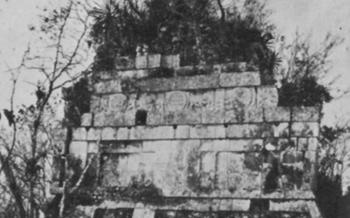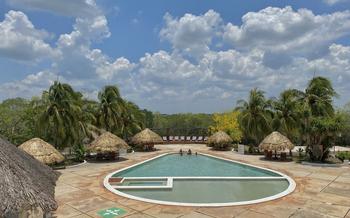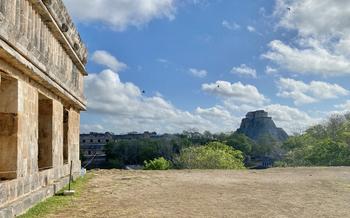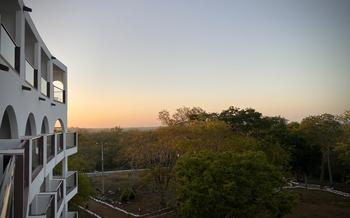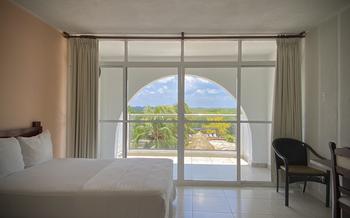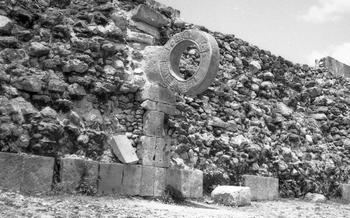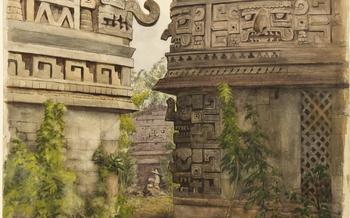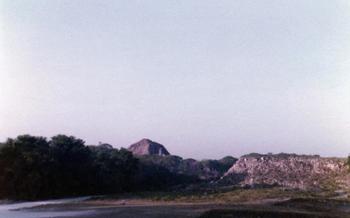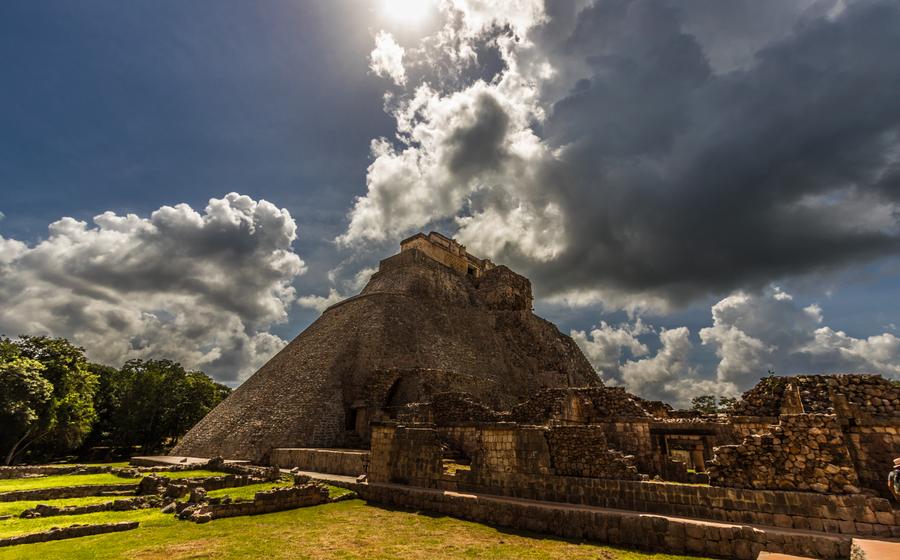
Hecelchakan Town
- Uxmal, a Journey Through Time
- Exploring the City
- The Pyramid of the Magician
- The Governor's Palace
- The Great Ball Court
- The Nunnery Quadrangle
- The House of the Turtles
- The Temple of the Birds
- The Red House
- The Stelae and Altars
- The Cenote of Sacrifice
- The Museum of Uxmal
- Practical Information for Exploring Uxmal
- Entrance Fees and Hours of Operation
- Best Time to Visit
- Accommodation and Dining
- Getting Around
- Getting There
- Insider Tip: Unveiling the Hidden Splendor of the Cenote Xooch
Uxmal, a Journey Through Time
Uxmal, an ancient Maya city nestled in the heart of the Yucatan Peninsula, holds a profound historical significance. Once a thriving metropolis, Uxmal played a pivotal role in the political and cultural landscape of the region. Its well-preserved ruins, adorned with intricate carvings and towering pyramids, stand as a testament to the ingenuity and artistry of its ancient inhabitants. Uxmal's unique architectural style, characterized by intricate geometric patterns and elaborate sculptures, sets it apart from other Maya cities. Recognized for its exceptional cultural value, Uxmal has earned the prestigious distinction of being designated a UNESCO World Heritage Site, solidifying its status as a must-see destination for history enthusiasts and travelers seeking to unravel the mysteries of the Maya civilization.
Exploring the City
The ancient city of Uxmal is divided into several groups of structures, each with its own unique character and significance. The main attractions include the Pyramid of the Magician, the Governor's Palace, the Great Ball Court, the Nunnery Quadrangle, the House of the Turtles, the Temple of the Birds, the Red House, and the Cenote of Sacrifice.
To make the most of your visit, it is helpful to have a map or guide to help you navigate the site. You can purchase a map at the entrance to the site or download a digital version online.
A suggested itinerary for exploring the ruins could include starting with the Pyramid of the Magician, which is the most iconic structure at Uxmal. From there, you can walk to the Governor's Palace, which is located just to the west of the pyramid. After exploring the palace, you can head to the Great Ball Court, which is located to the south of the pyramid.
From the Great Ball Court, you can walk to the Nunnery Quadrangle, which is located to the east of the court. After exploring the quadrangle, you can head to the House of the Turtles, which is located to the south of the quadrangle. From the House of the Turtles, you can walk to the Temple of the Birds, which is located to the east of the house.
After exploring the Temple of the Birds, you can head to the Red House, which is located to the south of the temple. From the Red House, you can walk to the Cenote of Sacrifice, which is located to the west of the house.
The Pyramid of the Magician
Standing tall and majestic, the Pyramid of the Magician, also known as the Great Pyramid, is the most iconic structure in Uxmal. Its history is shrouded in mystery and legend, with various theories and tales surrounding its construction. The pyramid was likely built in the 10th century and served as a ceremonial center and a symbol of power for the Maya rulers.
The pyramid's unique architectural features set it apart from others in the region. It features a series of masks of the rain god Chaac adorning its facade, symbolizing the Maya's reliance on agriculture and their reverence for water. The intricate carvings and sculptures on the pyramid showcase the exceptional craftsmanship of the Maya builders.
One of the most fascinating aspects of the Pyramid of the Magician is the legend associated with its construction. It is said that the pyramid was built by a sorcerer or magician named Ah Kin May in a single night, using magic and supernatural powers. The legend adds to the mystique of the pyramid and highlights the Maya's belief in the supernatural and their reverence for their spiritual leaders.
Visitors to Uxmal can climb to the top of the pyramid for breathtaking views of the surrounding jungle and the ancient city. The climb is challenging but rewarding, offering a unique perspective and a deeper appreciation for the architectural prowess of the Maya.
The Governor's Palace
The Governor's Palace, also known as the Palace of the Governors, is one of the most impressive structures in Uxmal. It is a large, multi-room building that showcases the city's intricate architectural style and artistic prowess. The palace is believed to have been the residence of the city's ruler and his entourage.
The Governor's Palace is distinguished by its elaborate carvings, friezes, and sculptures. The facades are adorned with intricate geometric patterns, masks of the rain god Chaac, and representations of other deities and mythological figures. The interior of the palace features a series of interconnected rooms, each with its unique architectural details.
One of the most striking features of the Governor's Palace is its corbelled arch, a type of arch that is constructed without the use of a keystone. The palace's corbelled arch is one of the largest and best-preserved examples of this architectural technique in the Maya world.
The Governor's Palace has been the subject of much debate and speculation among archaeologists and historians. Some believe that the palace was used exclusively by the city's ruler, while others propose that it may have served multiple functions, such as a ceremonial center or a meeting place for the city's elite.
Despite the ongoing debates, the Governor's Palace remains one of the most iconic structures in Uxmal. Its grandeur and intricate artistry offer a glimpse into the power and sophistication of the ancient Maya civilization.
The Great Ball Court
The Great Ball Court at Uxmal is a testament to the cultural and sporting significance of the ancient Maya civilization. Measuring approximately 95 meters in length and 30 meters in width, this colossal court is one of the largest and best-preserved in Mesoamerica. Flanked by two towering parallel structures, the court provided a grand stage for the ritualistic ballgame that held profound religious and social importance for the Maya.
The rules of the Mesoamerican ballgame remain shrouded in mystery, but archaeologists believe it was played with a solid rubber ball that could weigh up to four kilograms. Players used their hips, elbows, and knees to keep the ball in play, aiming to pass it through stone hoops suspended high on the walls of the court. The game was not merely a sport but a symbolic representation of cosmic battles and the struggle between life and death.
Excavations have uncovered fascinating archaeological evidence within the ball court. Numerous stone markers, known as marcadores, were found embedded in the ground along the court's central axis. These markers likely served as targets or obstacles for the players, adding an element of complexity and challenge to the game.
The Great Ball Court at Uxmal is not just a historical relic but a symbol of the cultural and sporting prowess of the ancient Maya. Visitors can marvel at the sheer size and grandeur of the court, imagining the spectacle and excitement that unfolded within its walls centuries ago.
The Nunnery Quadrangle
Among the many impressive structures within Uxmal, the Nunnery Quadrangle stands out for its intricate architectural details and historical significance. This complex of buildings, constructed around a central courtyard, showcases the exceptional craftsmanship of the ancient Maya builders. The quadrangle is renowned for its arched doorways, corbelled vaults, and elaborate friezes depicting various scenes from Maya mythology and daily life.
The name "Nunnery Quadrangle" is a misnomer, as there is no evidence to suggest that it was used as a convent or religious center. Instead, scholars believe that it served as an administrative or residential complex for the city's elite. The quadrangle's proximity to the Governor's Palace and the Temple of the Magician further supports this theory.
Exploring the Nunnery Quadrangle is a captivating experience, as each building offers unique insights into Maya culture and architecture. The intricate carvings and friezes that adorn the walls tell stories of gods, rulers, and everyday life, providing a glimpse into the complex beliefs and traditions of the ancient Maya civilization.
The House of the Turtles
Among the many impressive structures in Uxmal, the House of the Turtles stands out for its intricate carvings and historical significance. This small but captivating building is located on the eastern side of the Nunnery Quadrangle and is believed to have been a residence for high-ranking Maya officials or priests.
The most striking feature of the House of the Turtles is its facade, adorned with a series of beautifully carved turtle motifs. The turtles, which hold a special place in Maya mythology and cosmology, symbolize fertility, creation, and the underworld. The carvings showcase the Maya's exceptional artistry and their deep connection to the natural world.
In addition to its turtle motifs, the House of the Turtles is notable for its well-preserved corbelled arch, a type of arch constructed without the use of a keystone. The arch spans the entrance to the building and demonstrates the Maya's advanced architectural skills.
Although the exact purpose of the House of the Turtles remains a subject of debate among archaeologists, it is believed to have served as a residential or administrative building for the Maya elite. The presence of elaborate carvings and its proximity to the Nunnery Quadrangle suggest that it was a place of importance within the ancient Maya city.
Visitors to Uxmal should not miss the opportunity to admire the House of the Turtles and appreciate its intricate carvings and historical significance. This small building offers a glimpse into the artistry, beliefs, and daily life of the ancient Maya people.
The Temple of the Birds
Standing tall amidst the ruins of Uxmal, the Temple of the Birds is a testament to the artistic prowess and religious beliefs of the ancient Maya. Constructed during the Late Classic period, this temple showcases intricate carvings of birds, animals, and mythical creatures that adorn its facade. The temple's name derives from the abundance of bird motifs, which are believed to represent the Maya rain god, Chaac.
The Temple of the Birds is a unique and captivating structure that invites visitors to marvel at the artistry and symbolism of Maya culture. Its intricate carvings depict a variety of birds, including parrots, owls, and vultures, as well as other animals such as monkeys, turtles, and serpents. These carvings are believed to have served as a means of communication with the gods, representing prayers for rain, fertility, and protection.
The temple's facade is further adorned with human figures engaged in various activities, such as dancing, playing instruments, and making offerings. These carvings offer a glimpse into the daily lives and rituals of the ancient Maya, providing valuable insights into their culture and beliefs.
As you explore the Temple of the Birds, take a moment to admire the intricate details and symbolism that make this structure so remarkable. Let your imagination soar as you contemplate the stories and beliefs that inspired its creation.
The Red House
The Red House, or Casa Roja in Spanish, is a unique and captivating building located within the archaeological site of Uxmal. Its striking red-painted stucco exterior, which gives it its distinctive name, sets it apart from the other structures in the city. The Red House is believed to have been constructed during the Late Classic period (600-900 AD) and served as an important administrative or residential building.
The Red House showcases the exceptional craftsmanship and attention to detail characteristic of Maya architecture. Its facade features intricate carvings and moldings, depicting various geometric patterns, stylized human figures, and mythical creatures. The building's interior is equally impressive, with several chambers and rooms, each adorned with unique decorative elements.
The Red House's distinct red color is particularly intriguing. It is believed that the Mayas used a natural pigment derived from a local plant or mineral to create this vibrant hue. The red color may have held symbolic or religious significance for the ancient Maya, as it was often associated with power, royalty, and the sun.
The exact purpose of the Red House remains a subject of debate among archaeologists and historians. Some theories suggest that it may have been used as a palace or residence for high-ranking officials or members of the ruling elite. Others believe that it may have served as an administrative center or a place for conducting important ceremonies and rituals.
Regardless of its precise function, the Red House stands as a testament to the ingenuity and artistry of the ancient Maya. Its striking red exterior and intricate carvings make it a must-see attraction for visitors exploring the ruins of Uxmal.
The Stelae and Altars
Uxmal's archaeological site is rich in stelae and altars, intricate monuments that provide valuable insights into the ancient Maya civilization. These carved stone pillars and altars often feature elaborate glyphs, bas-reliefs, and inscriptions that narrate historical events, commemorate rulers, or mark significant dates.
One of the most notable stelae at Uxmal is Stela 11, located in the Great Plaza. It depicts a Maya ruler named Chan Chak K'ak'nal Ajaw seated on a throne, adorned with intricate headdresses and jewelry. The stela also features hieroglyphic inscriptions that provide genealogical information and details about the ruler's reign.
Another significant stela, Stela 14, is found in the Nunnery Quadrangle. It portrays a Maya ruler engaged in a ritual bloodletting ceremony, a common practice among the Maya to appease the gods and ensure divine favor. The stela's intricate carvings offer a glimpse into the religious beliefs and practices of the ancient Maya.
The altars at Uxmal are equally impressive, showcasing the artistic prowess of the Maya craftsmen. Altar 1, located in the Governor's Palace, is adorned with intricate carvings of human figures, animals, and mythological creatures. It is believed to have been used for offerings and rituals related to the ruling dynasty.
These stelae and altars serve as valuable historical records, providing insights into the political, religious, and cultural aspects of the ancient Maya civilization. By studying these monuments, archaeologists and historians can piece together the rich narrative of Uxmal and its significance in the Maya world.
The Cenote of Sacrifice
In the heart of Uxmal, veiled in mystery and steeped in ancient rituals, lies the Cenote of Sacrifice. This sacred well, located just north of the Nunnery Quadrangle, served as a significant site for Maya religious ceremonies and sacrificial offerings. The Maya believed that cenotes were portals to the underworld, a place where gods and ancestors resided.
Archaeological excavations have revealed an array of artifacts within the Cenote of Sacrifice, including jade, gold, and ceramic offerings, as well as human remains. These discoveries suggest that the Maya conducted rituals and sacrifices at the cenote, seeking to honor their gods and ensure the well-being of their community.
Visitors to Uxmal can catch a glimpse of this sacred site, a testament to the deep spiritual beliefs of the ancient Maya. While swimming or diving in the cenote is prohibited due to its cultural and historical significance, visitors can stand at the edge of the platform and peer into the depths of this mystical well, connecting with the spiritual essence of Uxmal's past.
The Museum of Uxmal
To delve deeper into the history and culture of Uxmal, visit the on-site museum, located just outside the archaeological site. This modern facility houses a collection of artifacts, sculptures, and replicas that provide a comprehensive overview of the ancient Maya city.
Among the highlights of the museum are intricate ceramic vessels, finely carved jade ornaments, and impressive stone sculptures that depict Maya deities, rulers, and mythological scenes. The museum also features informative displays that explain the significance of Uxmal's architecture, its role in Maya society, and the daily lives of its inhabitants.
To make the most of your visit, take your time to explore the various exhibits and read the accompanying descriptions. The museum staff is also available to answer any questions and provide additional insights into the fascinating world of the ancient Maya.
A visit to the Museum of Uxmal is a great way to complement your exploration of the ruins and gain a deeper understanding of this remarkable ancient city.
Practical Information for Exploring Uxmal
Entrance Fees and Hours of Operation
- Entrance Fee: The entrance fee to Uxmal is 500 pesos for adults and 250 pesos for children.
- Hours of Operation: Uxmal is open to visitors daily from 8 am to 5 pm.
Best Time to Visit
The best time to visit Uxmal is during the shoulder seasons, which are April-May and September-October. During these months, the weather is generally pleasant, with warm days and cool nights, and the crowds are smaller compared to the peak season.
Accommodation and Dining
There are several accommodation options available near Uxmal, ranging from budget-friendly hostels to luxurious resorts. Some popular choices include:
- Hotel Uxmal: A mid-range hotel located just outside the archaeological site, offering comfortable rooms and a swimming pool.
- Hacienda Uxmal Plantation & Museum: A luxury resort set on a former hacienda, with beautifully restored rooms, a spa, and a golf course.
- Restaurante La Hacienda Uxmal: A popular restaurant serving traditional Yucatecan cuisine, located near the archaeological site.
- El Pueblito Restaurant: A casual restaurant offering a variety of Mexican dishes, located in the town of Santa Elena.
Getting Around
The best way to get around Uxmal is on foot. The archaeological site is relatively small and easy to navigate, with well-marked trails and paths. Visitors can also rent bicycles at the entrance to the site.
Getting There
Reaching Uxmal is relatively easy, with several transportation options available. For a hassle-free experience, guided tours from major cities like Mérida or Cancún are a popular choice. These tours typically include round-trip transportation, a knowledgeable guide, and entrance fees.
If you prefer a more independent adventure, public transportation is an affordable option. From Mérida, catch a bus bound for Uxmal, which takes around 1 hour and 30 minutes. Once in Uxmal, local taxis or tuk-tuks can take you to the entrance of the archaeological site.
For those who enjoy the freedom of self-paced exploration, renting a car is a great option. From Mérida, take Highway 261 south for approximately 1 hour and 15 minutes. The drive offers scenic views of the Yucatán countryside. Parking is available near the entrance of the site, making it easy to start your exploration of Uxmal's wonders.
Insider Tip: Unveiling the Hidden Splendor of the Cenote Xooch
While exploring Uxmal's mesmerizing ruins, venture beyond the main attractions to discover a hidden gem – the Cenote Xooch. This secluded cenote, located a short walk from the archaeological site, offers a tranquil oasis amidst the ancient Mayan city. Immerse yourself in the crystal-clear waters, surrounded by lush vegetation and towering limestone walls. Take advantage of this serene spot to cool off, relax, and soak in the tranquil atmosphere. Remember to bring your swimsuit and a towel to make the most of this unique experience.
